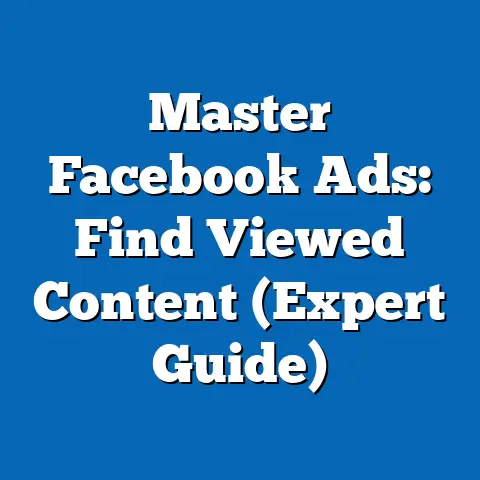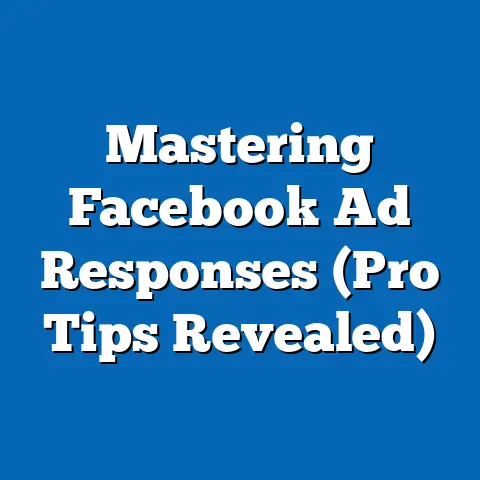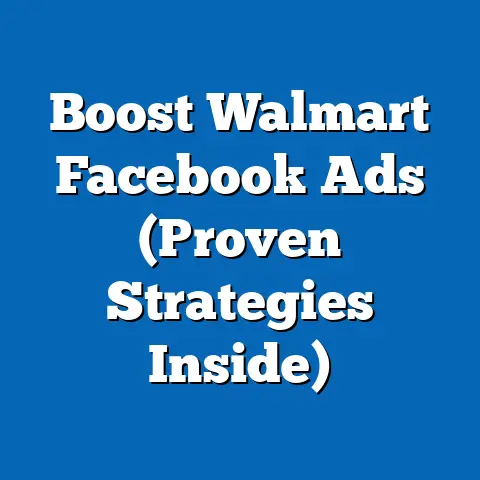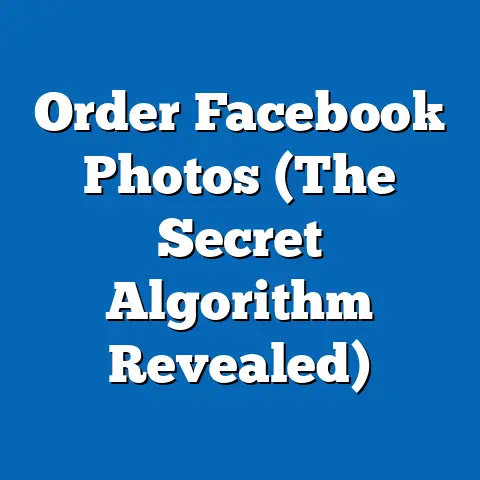Launch First Facebook Ads Today (Expert Tips Inside)
I’ve seen it happen countless times. A new business owner, brimming with excitement, dives headfirst into Facebook advertising, only to emerge weeks later, frustrated and with a lighter wallet. They targeted the wrong audience, set a budget that vanished in days, or created ads that blended into the newsfeed like wallpaper. The result? Wasted ad spend, a campaign that sputtered instead of soared, and a missed opportunity to connect with potential customers. I remember when I first started, I made many of these same mistakes. I quickly learned that launching Facebook ads without a solid understanding of its core components is like sailing a ship without a map – you might get somewhere, but it’s unlikely to be where you intended.
But don’t let that discourage you! Launching Facebook ads correctly from the start can lead to incredible results: a surge in brand awareness, a flood of new leads, and a significant boost to your bottom line. Understanding the key components of a successful campaign – from setting clear objectives to crafting compelling visuals – is the key to unlocking a higher return on investment (ROI) and turning your ad spend into a powerful growth engine. So, let’s dive in and equip you with the knowledge and tools you need to launch your first Facebook ads with confidence and achieve the results you deserve.
Section 1: Understanding Facebook Ads
Facebook Ads are essentially paid messages that businesses use to reach potential customers on the Facebook platform (which now encompasses Meta platforms like Instagram). They’re a powerful tool in the digital marketing arsenal, allowing you to connect with a vast and diverse audience based on specific demographics, interests, and behaviors. Think of them as a digital billboard, but instead of being limited to drivers passing by, your message can reach anyone, anywhere, who fits your ideal customer profile.
Different Ad Formats
Facebook offers a variety of ad formats to suit different marketing objectives and creative preferences. Here are a few popular options:
- Image Ads: Simple yet effective, image ads use a single image to convey your message. They’re great for showcasing products or highlighting key benefits.
- Video Ads: Video ads are more engaging and can tell a story or demonstrate a product in action. They’re perfect for capturing attention and generating interest.
- Carousel Ads: Carousel ads allow you to display multiple images or videos in a single ad unit, each with its own headline, description, and link. This format is ideal for showcasing a range of products or highlighting different features of a single product.
- Collection Ads: Collection ads are designed for e-commerce businesses and allow users to browse and purchase products directly from the ad. They typically feature a hero image or video along with a selection of related products.
Advantages of Facebook Ads
What sets Facebook Ads apart from traditional advertising methods like print or television? The answer lies in their precision and measurability.
- Precise Targeting: Facebook’s robust targeting options allow you to reach a highly specific audience based on demographics, interests, behaviors, and even custom audiences built from your own customer data. This level of targeting ensures that your message reaches the people most likely to be interested in your products or services.
- Measurable Results: Unlike traditional advertising, Facebook Ads provide detailed metrics on ad performance, allowing you to track key indicators like reach, impressions, clicks, conversions, and ROI. This data allows you to optimize your campaigns in real-time and maximize your ad spend.
The Facebook Ads Manager
The Facebook Ads Manager is your central hub for creating, managing, and analyzing your Facebook ad campaigns. It’s a powerful tool that provides access to all of Facebook’s advertising features, from setting up your campaign and defining your target audience to crafting your ad creative and tracking your results. I always recommend getting familiar with the Ads Manager interface before launching your first campaign. Take some time to explore the different sections and features to get a feel for how it works.
Key Takeaway: Facebook Ads are a powerful tool for reaching a specific audience with targeted messages and measurable results. The Facebook Ads Manager is your central hub for creating and managing your campaigns.
Section 2: Setting Clear Objectives
Before you even think about creating an ad, it’s crucial to define what you want to achieve with your campaign. What is the ultimate goal? What action do you want people to take after seeing your ad? Setting clear, measurable objectives is the foundation of a successful Facebook Ads strategy. Without a clear objective, you’re essentially throwing money at the wall and hoping something sticks.
Common Objectives
Facebook offers a range of campaign objectives designed to help you achieve different marketing goals. Here are a few common options:
- Brand Awareness: This objective is designed to increase the visibility of your brand and reach a broad audience. It’s ideal for introducing your brand to new customers or reinforcing your brand message to existing customers.
- Traffic: This objective is designed to drive traffic to your website or app. It’s perfect for promoting blog posts, product pages, or other content that you want people to visit.
- Engagement: This objective is designed to increase engagement with your Facebook page or posts. It’s ideal for generating likes, comments, shares, and event RSVPs.
- Leads: This objective is designed to collect leads for your business. It’s perfect for generating email subscribers, requesting quotes, or scheduling appointments.
- Sales: This objective is designed to drive sales of your products or services. It’s ideal for promoting e-commerce products or driving online conversions.
Aligning Objectives with Business Goals
Your ad objectives should always align with your overall business goals. For example, if your business goal is to increase sales by 20% in the next quarter, your ad objective might be to drive sales of a specific product or service. If your business goal is to increase brand awareness, your ad objective might be to reach a broader audience and generate more engagement with your Facebook page. I’ve seen many businesses make the mistake of running ads without a clear understanding of how they contribute to their overall business objectives. Don’t let that be you!
Examples
Let’s look at some examples of how different objectives can influence ad design and targeting options:
- Objective: Increase Brand Awareness
- Ad Design: Focus on visually appealing images or videos that showcase your brand’s personality and values.
- Targeting: Target a broad audience based on demographics and interests related to your industry.
- Objective: Generate Leads
- Ad Design: Include a clear call-to-action that encourages people to sign up for a free trial, download a lead magnet, or request a quote.
- Targeting: Target a specific audience based on demographics, interests, and behaviors related to your product or service.
- Ad Design: Focus on visually appealing images or videos that showcase your brand’s personality and values.
- Targeting: Target a broad audience based on demographics and interests related to your industry.
- Ad Design: Include a clear call-to-action that encourages people to sign up for a free trial, download a lead magnet, or request a quote.
- Targeting: Target a specific audience based on demographics, interests, and behaviors related to your product or service.
Key Takeaway: Setting clear, measurable objectives is crucial for a successful Facebook Ads campaign. Align your ad objectives with your overall business goals and tailor your ad design and targeting options accordingly.
Section 3: Audience Targeting
Audience targeting is the secret sauce of Facebook Ads. It’s what allows you to reach the right people with the right message at the right time. Instead of broadcasting your message to everyone and hoping for the best, you can focus your efforts on those who are most likely to be interested in your products or services. I always tell my clients, “It’s better to reach 100 people who are likely to buy than 1000 people who are not.”
Targeting Options
Facebook offers a wide range of targeting options to help you reach your ideal audience:
- Demographics: Target people based on age, gender, location, education, job title, and other demographic factors.
- Interests: Target people based on their interests, hobbies, and activities. Facebook gathers this information from the pages people like, the groups they join, and the content they engage with.
- Behaviors: Target people based on their online and offline behaviors, such as purchase history, travel habits, and device usage.
- Custom Audiences: Create custom audiences based on your own customer data, such as email lists, website visitors, and app users. This allows you to re-engage with existing customers or target people who have shown interest in your business.
- Lookalike Audiences: Create lookalike audiences based on your custom audiences. This allows you to reach new people who share similar characteristics and interests with your existing customers.
Researching Your Ideal Audience
Before you start creating your ads, take the time to research and define your ideal target audience. Who are they? What are their interests and needs? What are their pain points? The more you know about your target audience, the better you’ll be able to craft compelling ads that resonate with them.
Creating Buyer Personas
One of the best ways to understand and reach your potential customers is to create buyer personas. A buyer persona is a semi-fictional representation of your ideal customer, based on research and data about your existing customers and target market. Your buyer persona should include information about their demographics, interests, behaviors, motivations, and goals. I find that giving my personas names and even finding stock photos that represent them helps me really visualize who I’m trying to reach.
Key Takeaway: Audience targeting is crucial for reaching the right people with the right message. Utilize Facebook’s various targeting options and take the time to research and define your ideal target audience.
Section 4: Crafting Compelling Ad Copy and Visuals
Even with the most precise targeting in the world, your ads will fall flat if they don’t capture the attention of your target audience. Engaging ad copy and eye-catching visuals are essential for standing out in the crowded Facebook newsfeed and convincing people to take action. I often tell my clients, “Your ad is competing with baby photos, cat videos, and political rants. It has to be good!”
Effective Ad Copy
Your ad copy should be clear, concise, and compelling. It should grab the reader’s attention, highlight the benefits of your product or service, and include a clear call-to-action. Here are a few tips for writing effective ad copy:
- Use Clear Calls-to-Action: Tell people exactly what you want them to do, such as “Shop Now,” “Learn More,” or “Sign Up Today.”
- Address Customer Pain Points: Identify the problems that your target audience is facing and explain how your product or service can solve them.
- Keep It Concise: People are scrolling quickly through their newsfeed, so you need to get your message across quickly and efficiently.
- Use Strong Verbs and Adjectives: Use words that are action-oriented and descriptive to make your ad copy more engaging.
The Role of Visuals
Visuals play a crucial role in Facebook Ads. A high-quality image or video can instantly capture attention and convey your message more effectively than text alone. Here are a few tips for choosing the right visuals:
- Use High-Quality Images and Videos: Avoid blurry or pixelated images. Use visuals that are clear, well-lit, and visually appealing.
- Align Visuals with Ad Message: Your visuals should be relevant to your ad copy and reinforce your message.
- Use Visuals That Evoke Emotion: Choose visuals that evoke positive emotions, such as happiness, excitement, or trust.
Examples of Successful Ads
Let’s look at some examples of successful Facebook Ads and analyze what makes them effective:
- Example 1: Shopify – I love their ads. They often use short, engaging videos that showcase real people using their platform to build successful online stores. The copy is concise and highlights the ease of use and the potential for growth.
- Example 2: Grammarly – Grammarly’s ads often feature screenshots of their tool in action, demonstrating how it can help people improve their writing. The copy focuses on the benefits of using Grammarly, such as avoiding embarrassing errors and improving communication skills.
Key Takeaway: Engaging ad copy and eye-catching visuals are essential for capturing attention and convincing people to take action. Use clear calls-to-action, address customer pain points, and choose high-quality visuals that are relevant to your ad message.
Section 5: Budgeting and Bidding Strategies
Setting the right budget and choosing the right bidding strategy are crucial for maximizing your ROI on Facebook Ads. Too little budget and your ads won’t reach enough people. Too much budget and you risk wasting money on irrelevant clicks and impressions. I always tell my clients, “It’s not about spending the most money, it’s about spending the money smartly.”
Budgeting Options
Facebook offers two main budgeting options:
- Daily Budget: This allows you to set a specific amount that you’re willing to spend each day.
- Lifetime Budget: This allows you to set a specific amount that you’re willing to spend over the entire duration of your campaign.
Determining an Appropriate Budget
How do you determine an appropriate budget for your Facebook Ads campaign? Here are a few factors to consider:
- Objectives: What are you trying to achieve with your campaign? Are you trying to generate leads, drive sales, or increase brand awareness? Different objectives require different budgets.
- Audience Size: How large is your target audience? The larger your audience, the more budget you’ll need to reach them effectively.
- Bidding Strategy: What bidding strategy are you using? Manual bidding typically requires a lower budget than automatic bidding.
- Industry: What is the average cost per click (CPC) in your industry? This will give you a benchmark for setting your budget.
Bidding Strategies
Facebook offers two main bidding strategies:
- Automatic Bidding: Facebook automatically sets your bids to get the most results for your budget. This is a good option for beginners who are not familiar with bidding strategies.
- Manual Bidding: You manually set your bids for each ad set. This gives you more control over your ad spend but requires more expertise.
Monitoring Ad Spend
It’s important to monitor your ad spend regularly to ensure that you’re staying within your budget and getting the results you want. The Facebook Ads Manager provides detailed reports on your ad spend, allowing you to track your daily and lifetime spend. I recommend checking your ad spend at least once a day to identify any potential issues and make adjustments as needed.
Key Takeaway: Setting the right budget and choosing the right bidding strategy are crucial for maximizing your ROI on Facebook Ads. Consider your objectives, audience size, and industry benchmarks when setting your budget, and monitor your ad spend regularly.
Section 6: Monitoring and Analyzing Results
Launching your ads is just the beginning. The real magic happens when you start monitoring and analyzing your results. This is where you learn what’s working, what’s not, and how to optimize your campaigns for even better performance. I often tell my clients, “Data is your best friend in the world of Facebook Ads.”
Key Metrics to Monitor
Here are a few key metrics to monitor in the Facebook Ads Manager:
- Reach: The number of unique people who saw your ads.
- Impressions: The number of times your ads were displayed.
- Click-Through Rate (CTR): The percentage of people who clicked on your ads after seeing them.
- Conversion Rate: The percentage of people who completed a desired action (e.g., making a purchase, signing up for a newsletter) after clicking on your ads.
- Cost Per Acquisition (CPA): The cost of acquiring a new customer through your ads.
Using Facebook Ads Manager and Other Analytics Tools
Making Data-Driven Decisions
The key to successful Facebook Ads is to use data to inform your decisions. If you see that your CTR is low, you might need to improve your ad copy or visuals. If you see that your CPA is high, you might need to adjust your targeting or bidding strategy. Don’t be afraid to experiment and try new things. The more you test and iterate, the better you’ll become at optimizing your campaigns for maximum performance. I once had a client whose CPA was through the roof. After analyzing the data, we discovered that their landing page was slow and difficult to navigate. Simply improving the landing page speed and user experience resulted in a dramatic decrease in CPA.
Key Takeaway: Tracking ad performance is essential for understanding what works and what doesn’t. Use Facebook Ads Manager and other analytics tools to assess campaign performance and make data-driven decisions to optimize future campaigns based on the analysis.
Conclusion
Launching Facebook Ads effectively is a journey, not a destination. It requires a commitment to learning, testing, and optimizing your campaigns over time. But the rewards are well worth the effort. By understanding the key components of a successful campaign – from setting clear objectives to crafting compelling visuals – you can unlock a higher return on investment (ROI) and turn your ad spend into a powerful growth engine.
I’ve shared a wealth of expert tips throughout this article, including the importance of precise targeting, engaging ad copy, and strategic budgeting. I encourage you to take action by applying these strategies to your first Facebook ad campaign. Don’t be afraid to experiment, make mistakes, and learn from your experiences. Remember, even the most experienced marketers started somewhere. By learning from common mistakes and implementing best practices, you can achieve incredible success with Facebook Ads and take your business to the next level. Now go out there and launch your first Facebook Ads with confidence!






